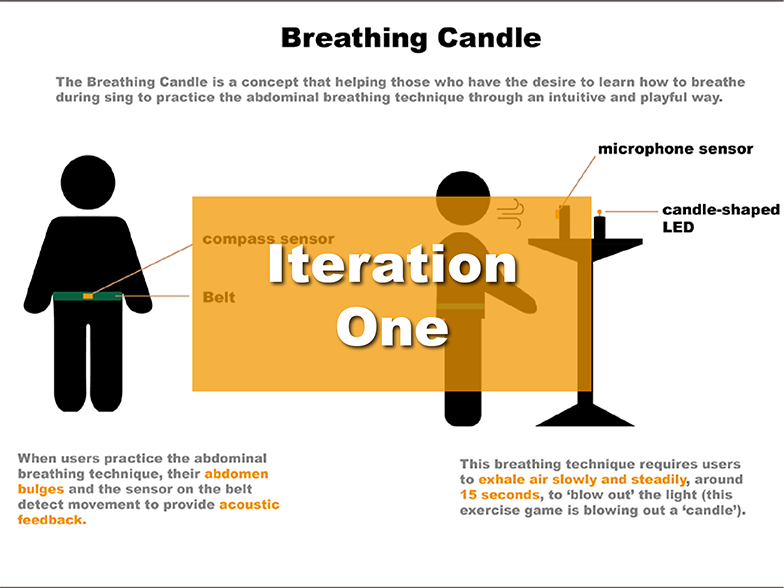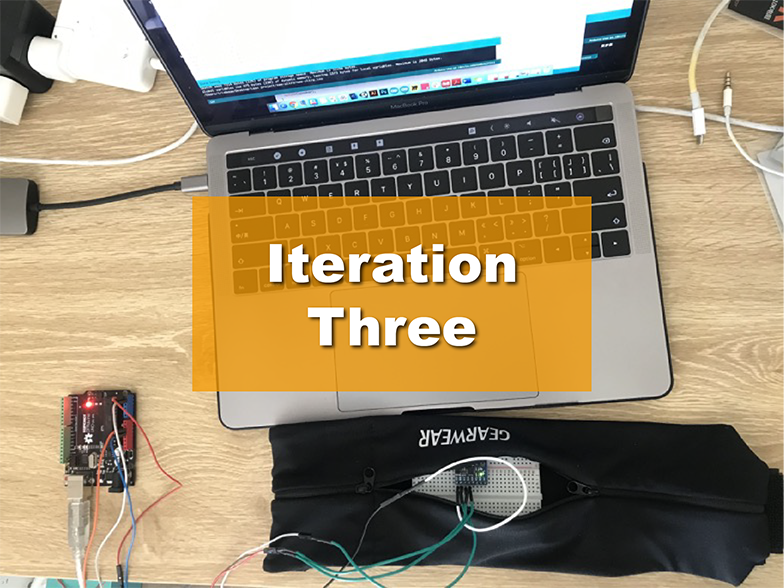The whole design process followed the user-centred and iterative design approaches, so user's participation informed the design of this project. Main activities, users’ involvement and key findings can be found in each iteration.
Iteration One
Background Research
The aim for this step is to get a better understanding of the abdominal breathing technique, including practice methods and important steps for practice. Actions I have taken were reviewing some literature and watching online tutorials.
Main take-aways here are:
The abdomen is one of the most important parts which will be used during practice.
Slowly and steadily deep breathing is required for practice.
Contextual Inquiry
Aims here are identifying target users’ needs, motivations and pain points in terms of practicing this breathing method. Actions I have taken were conducting semi-structured interviews with 4 participants (2 have learned this breathing technique and 2 have not) and controlled observations with both an experienced and novice participant.
Main take-aways here are:
Practicing breathing activities is an abstract exercise, which is frustrating to learners.
It is essential to get obvious and intuitive feedback for correct practice.
Users should take steady deep breathing rather than rapid shallow breathing.

Initial Concept
The initial concept is ‘Breathing Candle’, and main interactions are about two parts. For the ‘belt’, when users breathe in with the correct way, their abdomen will bulge, then trigger the compass sensor to get acoustic feedback. For ‘candle’ part, to achieve desired training results (breathe out with 15 seconds), users need to slowly and steadily to ‘blow out’ the candle-shaped LED. Therefore, they can also get visual feedback when practicing.
Remote Evaluation
Semi-structed interviews via Zoom with 1 novice and 1 skilled user were conducted to collect users’ opinions on intended physical form and interaction means of the initial concept. The first finding is that users are more interested in visually appealing feedback, and they suggested that lighting up some lights would be more effective than going out the ‘candle’ for giving visual feedback. Also, users suggested that it would be better to set some time intervals within the 15-second total practice time to give clearer feedback.
Iteration Two
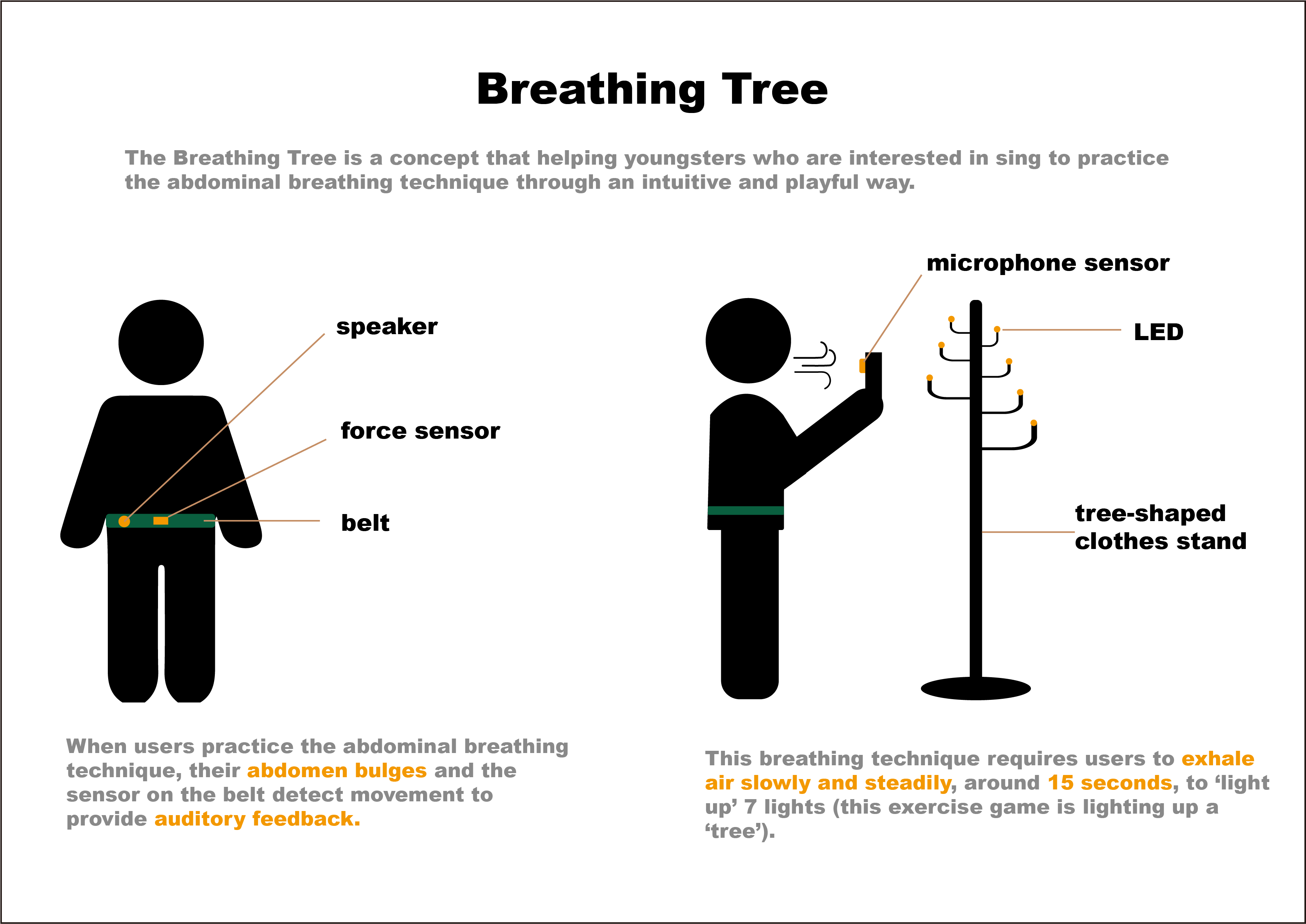
Updated Requirement
Want to know how we came up with this design concept? Please check out our team's design proposal and you will learn more about this project! Want to know how we came up with this design concept? Please check out our team's design proposal and you will learn more about this project! Want to know how we came up with this design concept?
Revised Concept
The updated concept is ‘Breathing Tree’. For the ‘belt’ part, force sensor is used to detect users’ abdomen movement, so as to trigger the audio output. For ‘tree’ part, to give users clear visual feedback, the total practicing time have been divided into 7 small intervals. Users can light up LED lights on the ‘tree’ every 2 seconds by breathing out stably. Also, the whole device also becomes a tree-shaped coat stand that fixes all LED lights.
Prototype updating
The prototype is consist of three parts: the belt, microphone and tree. The belt aims to detect the movement of the user's abdomen during breathing and give auditory feedback.
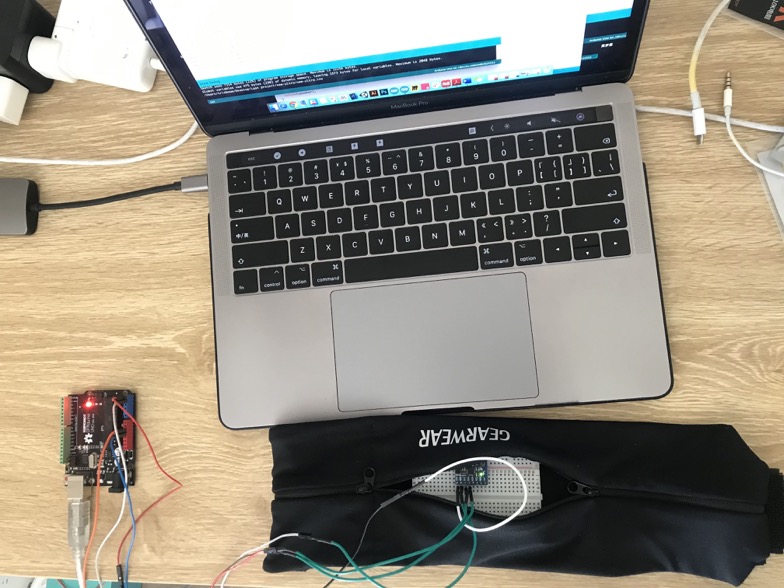
First, the accelerometer was used in the belt for collecting the data of users’ abdomen,
but the data is too complicated and sometimes is unstable.

Therefore, the force sensitive resister was used to replace that. Some sponges and
cardboard are used to wrap around the FSR for accurately detecting subtle movement data from the abdomen.
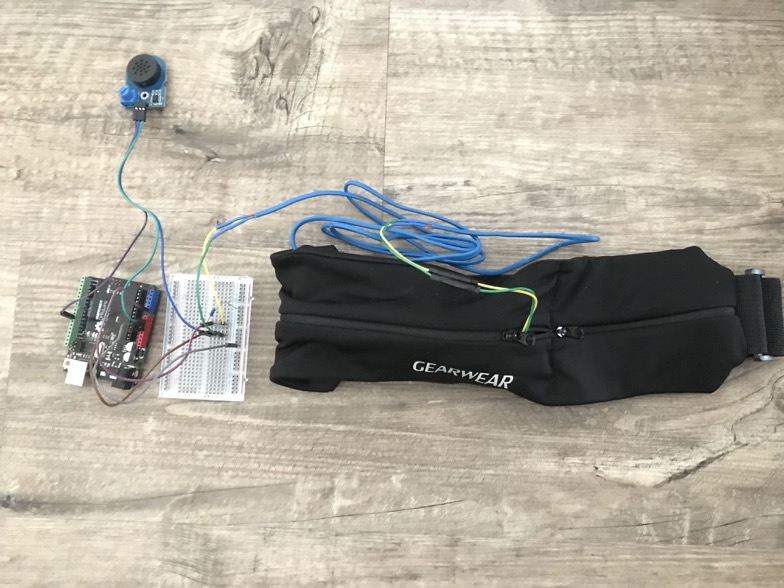
The updated belt part is an FSR was put into the running belt, which also connected to the
Arduino audio amplifier module to output audio.
The microphone can detect users' breathing out time, and then the tree lights up 7 LEDs according to the length of user's breathing outaction, so that give visual feedback.
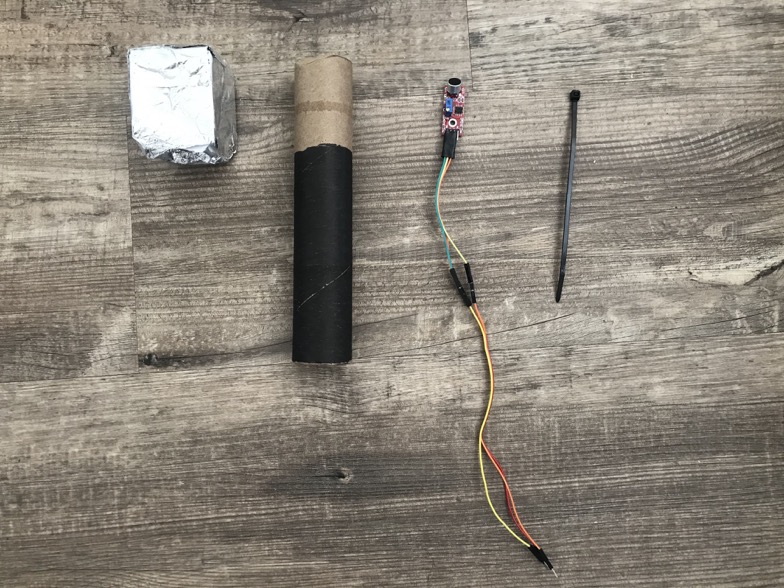
The microphone part of the prototype is built with a kitchen tissue roll, a piece of A4
paper and foil, and a close tie.
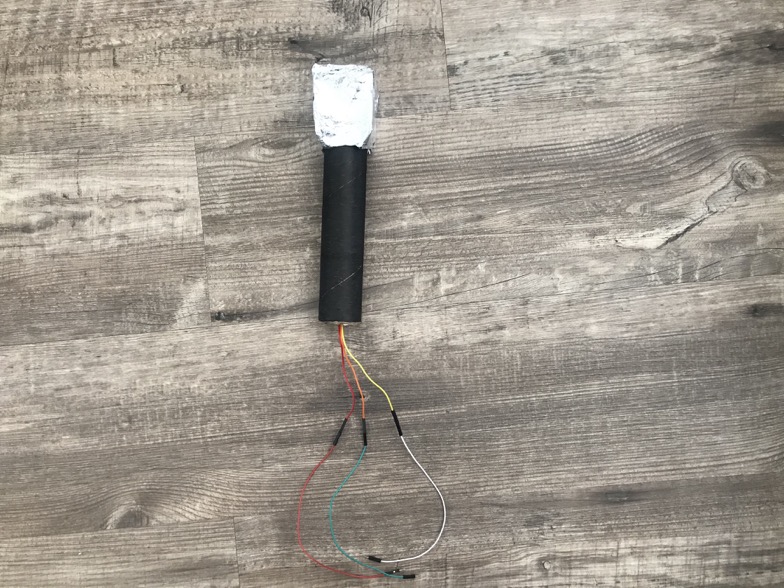
The kitchen tissue roll, A4 paper and foil are used to make the shape of the simulated microphone
and the close tie is used to fix the microphone sensor in the microphone model.
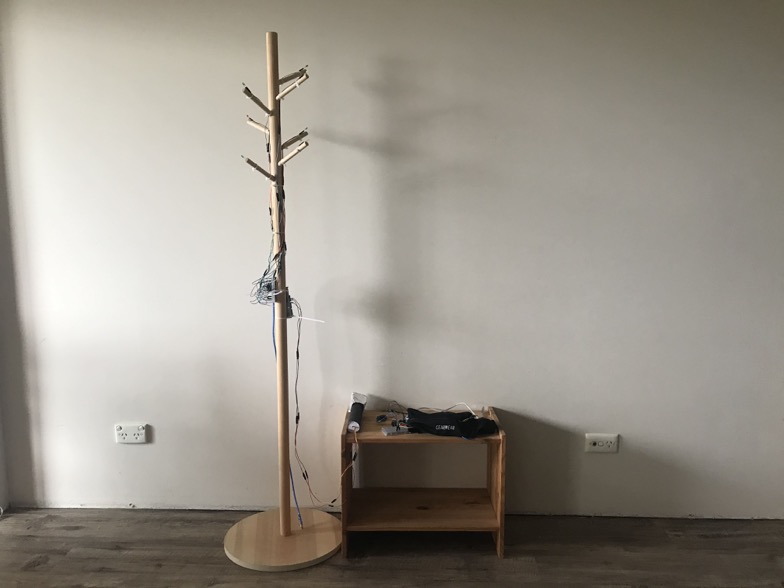
The breathing tree is built with a tree-shaped coat stand and some LEDs and wires. Each
LED light is attached to the ‘branch’ of the coat stand, and finally 7 LED lights have been attached.

User Testing
In this step, SUS evaluations were conducted with 3 users to gather their overall experience on intended experience, interaction flow, and physical forms of the concept. In order to observe how they naturally practice this breathing method and get clarification with some specific issues, controlled observations and follow-up interviews were also conducted.
Positive feedback is mainly about three aspects: First, quantified visual feedback is engaging and intuitive. Also, combining the concept to daily objects is playful. Finally, multi-sensory feedback is effective.
Users also give some suggestions on improvement. First, providing continuous visual feedback would be helpful (e.g. gradually lighting up). Also, adding decorations would make the tree more visually appealing.
Iteration Three
Updated Requirement
According to the evaluation results in the second iteration and the appraisal from other teams on my project, some changes have been proposed in terms of the visual and auditory feedback and the physical form of the project.
Visual FeedBack
First, instead of lighting up a LED light every two seconds, changing to gradually light up a LED light would be better,
because that can give users the continuous visual feedback.
Auditory feedback
Besides, sound from Arduino audio amplifier is not very polished, so as an update, using the alternative way (laptop speaker) to give auditory feedback. For using the laptop to control the audio output, Python will be used to receive the play instructions from Arduino.
Appearance
In order to make a more appealing appearance of the ‘tree’, adding some decorations to the ‘breathing tree’ is a potential change. Also, for giving users a more realistic interacting experience, it is also worth considering using the real microphone model.
Prototype updating
All LED lights of the 'breathing tree' have been updated to give users a more obvious and appealing visual feedback.
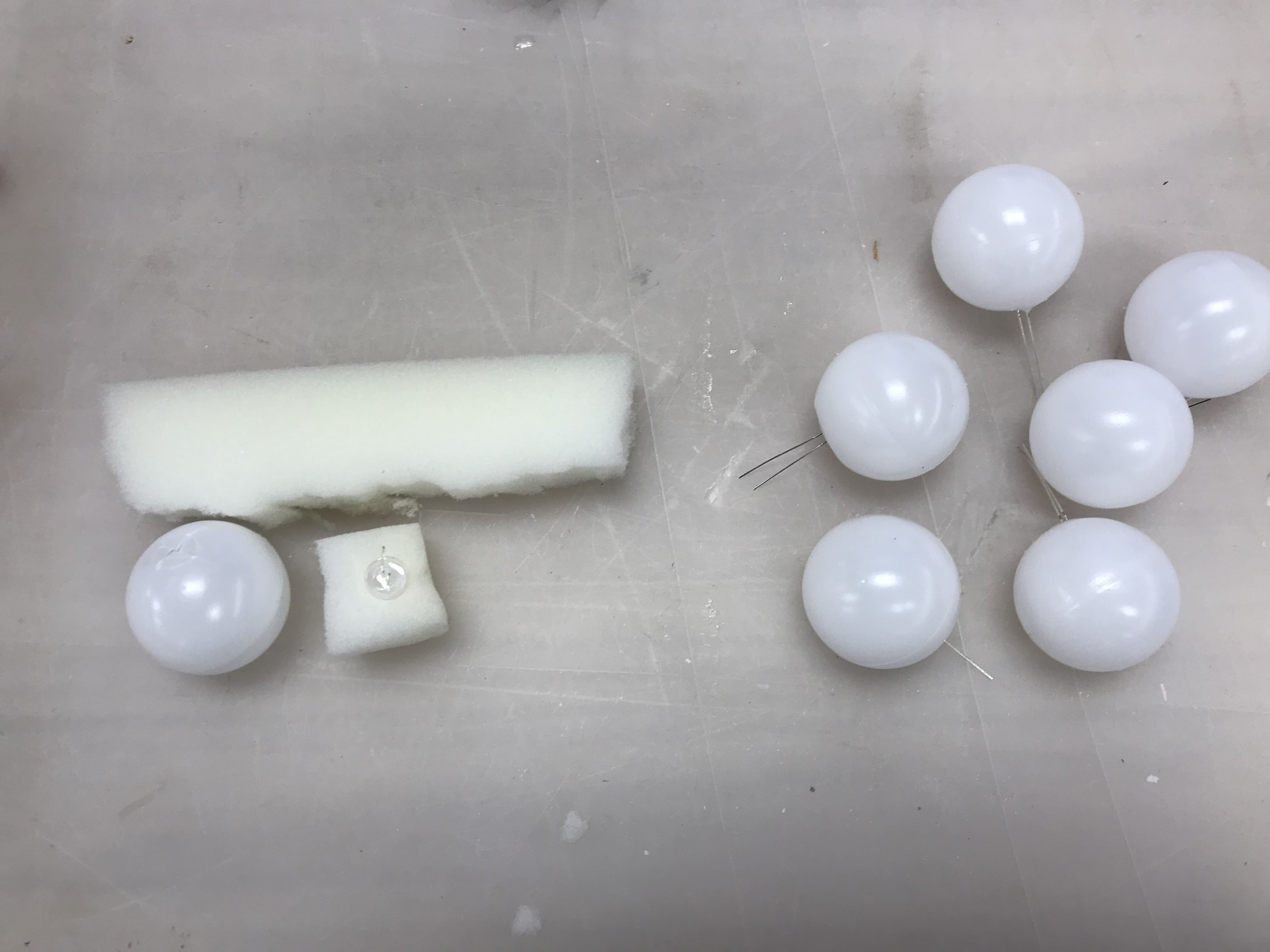
First, in order to get LEDs to have a better diffused lighting effect, I used the sponge to wrap up them
and put them into the table tennis balls.
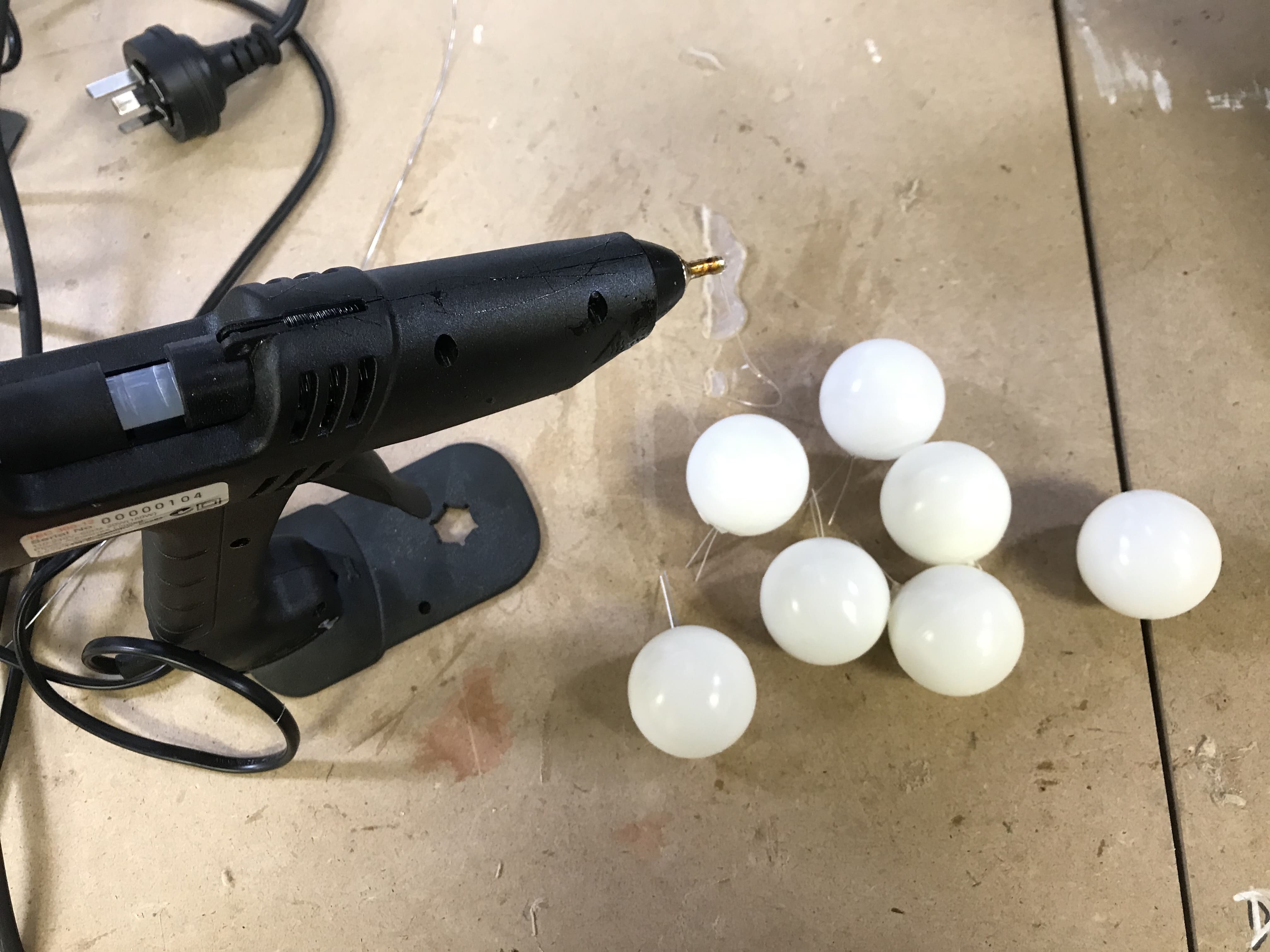
For fixing LED lights inside these balls, I also used the hot glue gun to seal the connection between each
of the LED and the ball.
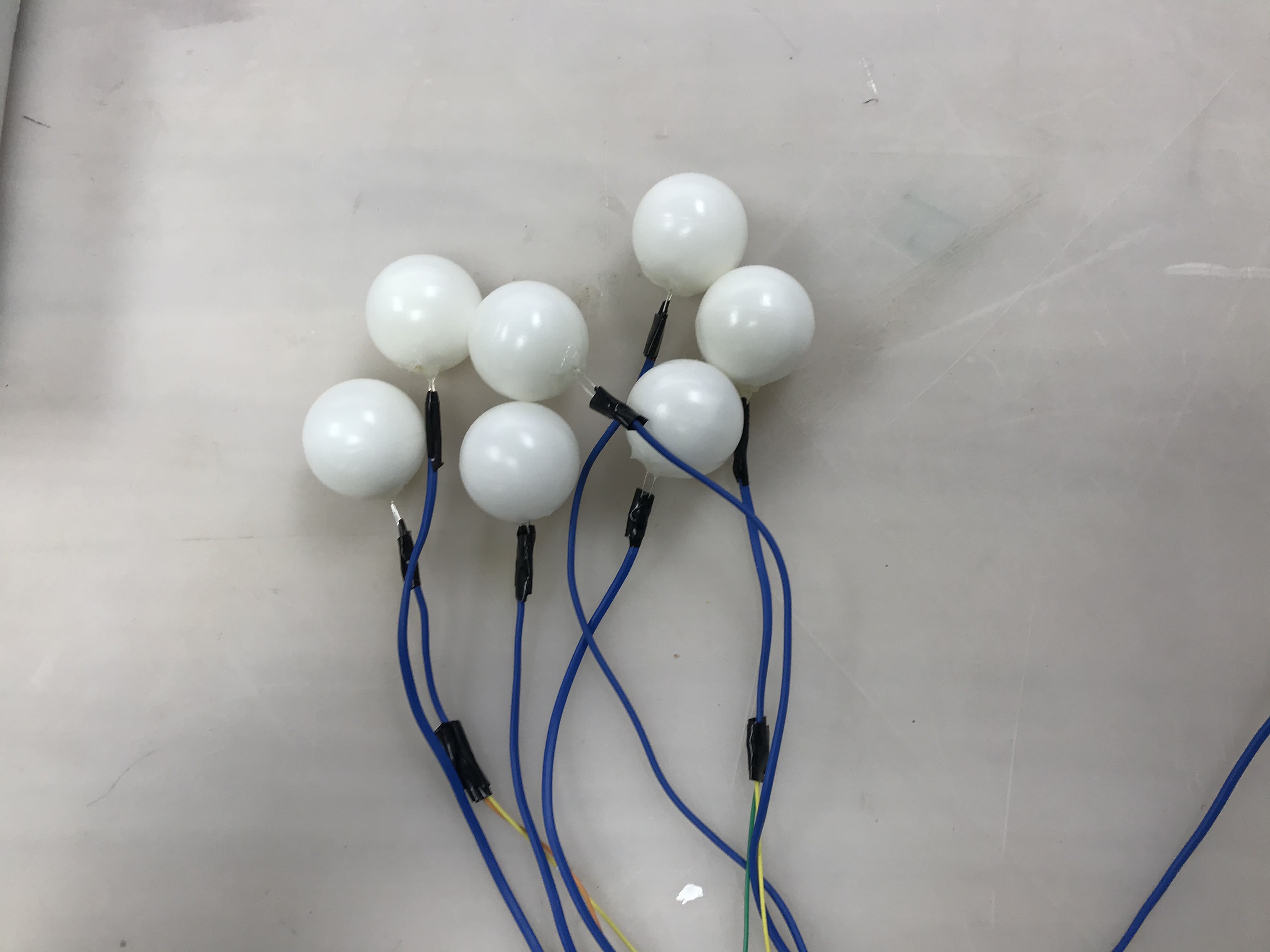
After all the materials were ready, I soldered a long wire to each ball for fitting different heights of the
‘branches’ of the ‘breathing tree’.
The microphone and the tree-shaped coat stand have also been improved to make the final product more polished.
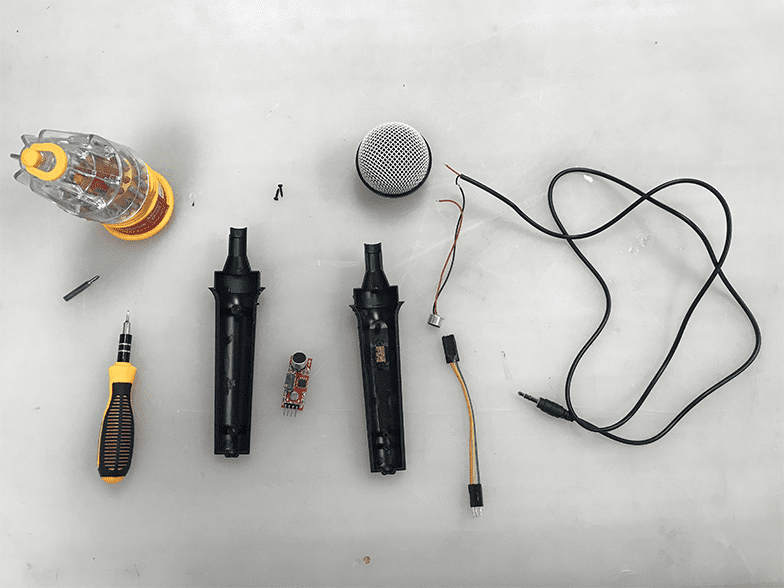
For giving users a more authentic interaction experience, I bought a real microphone and disassembled it,
so as to put the microphone sensor used for detecting users’ breath inside it.
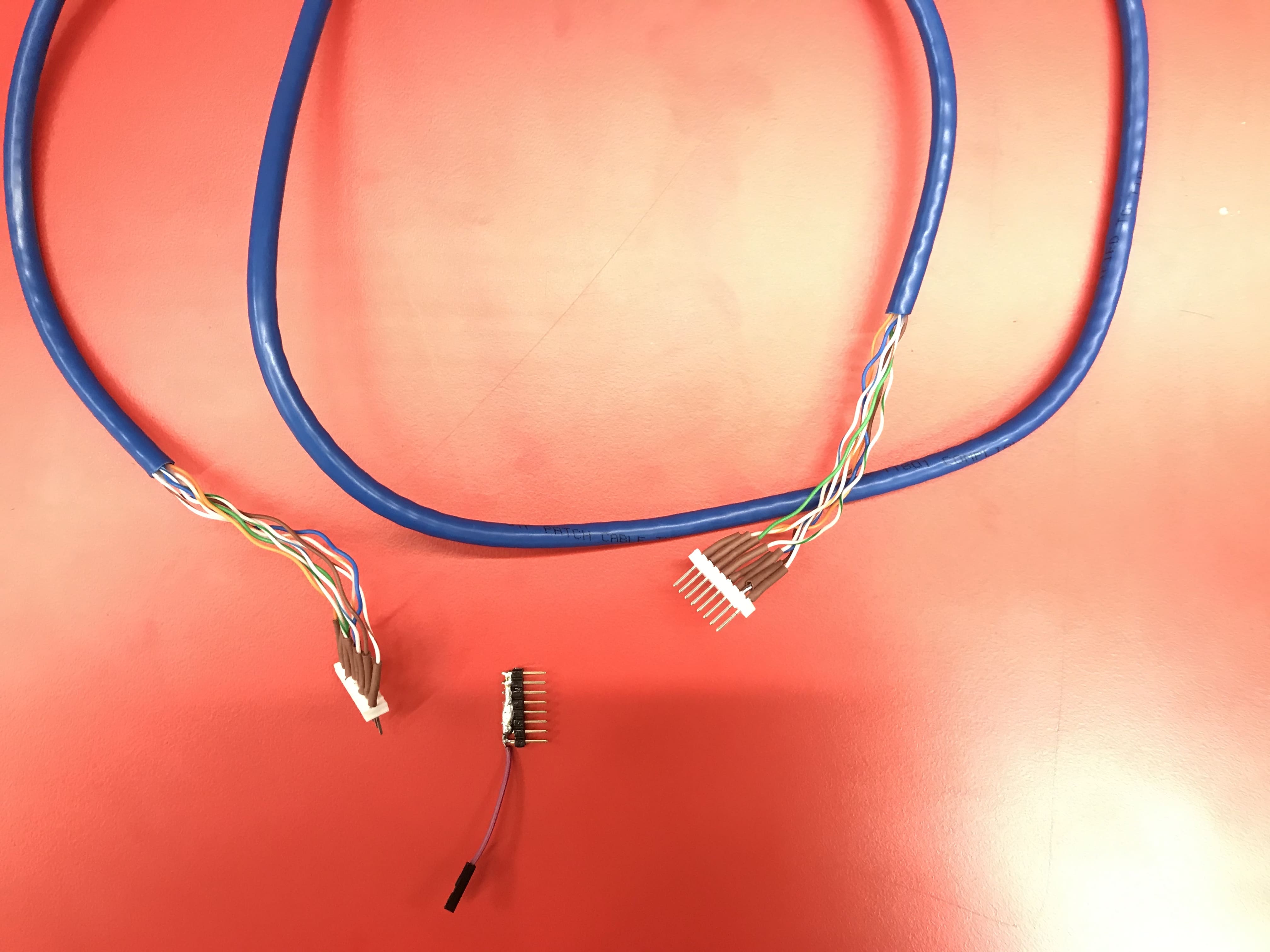
Also, to make wires of my prototype look less cluttered, I got a long wire which had 8 pins, and a soldered
pin ‘connector’ which had 7 pins. Therefore, each positive pole of 7 LEDs and all negative poles of them can
be connected to each pin of the wire.
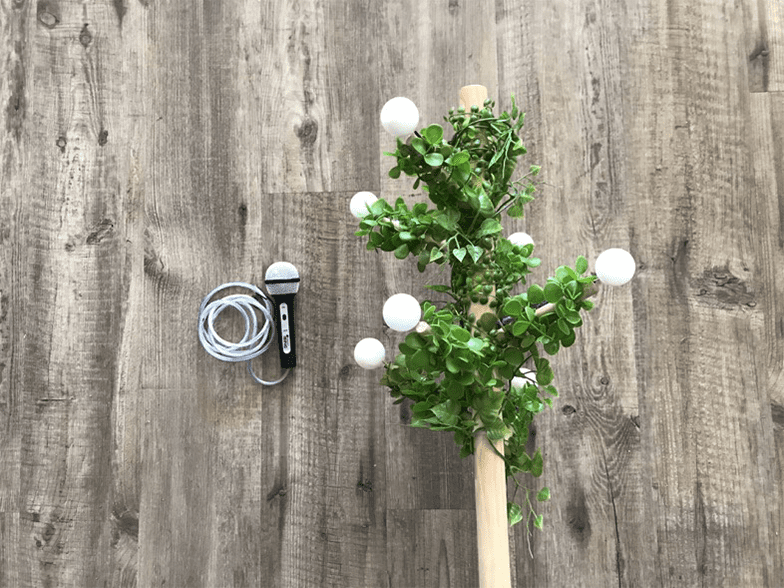
By adding decorations to the ‘breathing tree’ and connecting a long wire the microphone, all the wires of the
‘ball’ have been hidden and the appearance of the final product is more polished.
Final Exhibition
At the exhibition, some users interact with the product both online and in person, so that informal user testings were able to be conducted by interviewing them to share opinions about the whole concept, and / or observing how they naturally interact with the system. As a whole, the final proof-of-concept product have successfully met the project's desired outcomes in terms of both human values and the intended experience, which are enabling users get intuitive practicing feedback and playful practicing guidance.
Intuitive practicing feedback
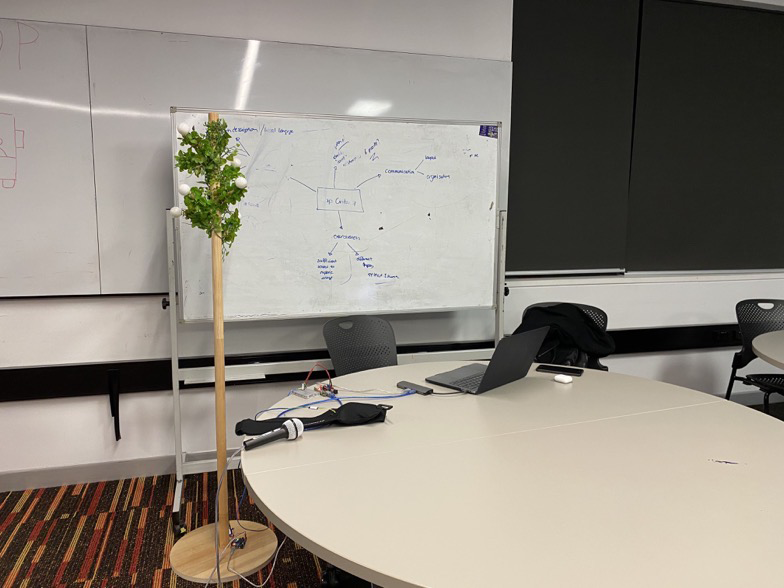
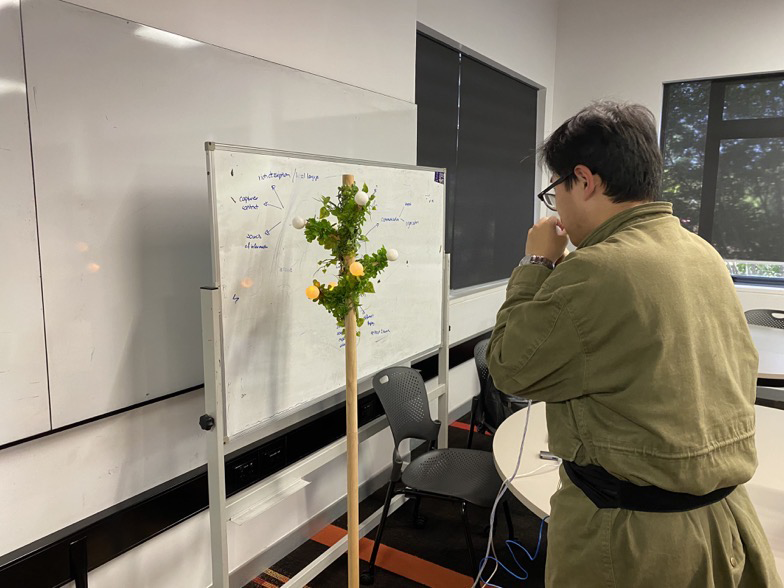
All participants reported that the combination of auditory and visual feedback allows them to clearly know whether they were breathing in the correct way or not. They thought the device could give them a clear idea of whether they were using the abdomen to breathe in and whether they were breathing out evenly, by measuring the length of their breath and the movement of their abdomen.
Playful practicing guidance
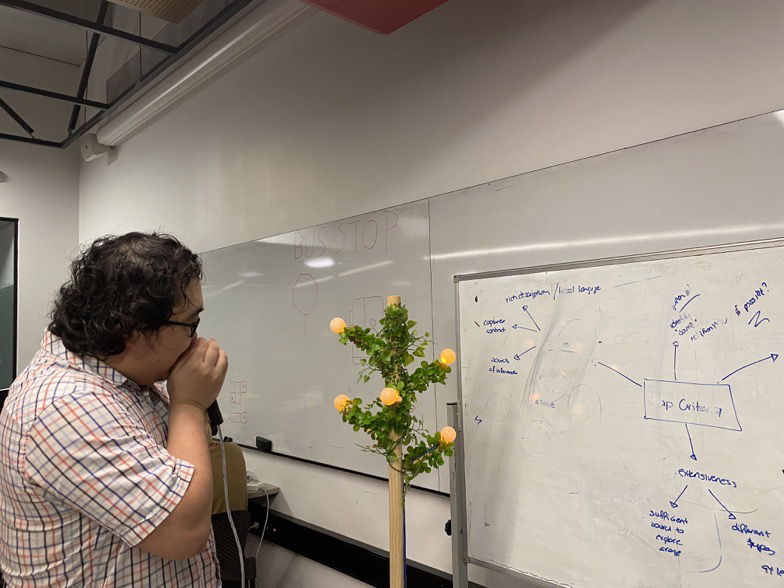
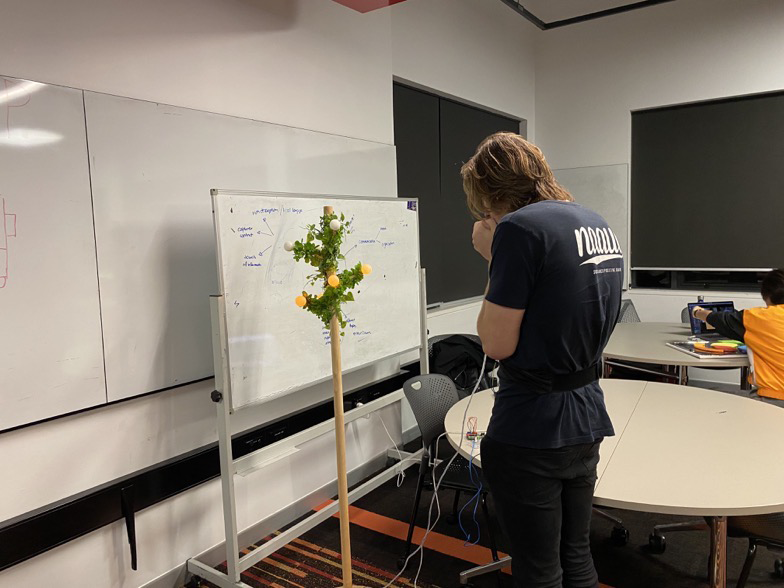
It’s also pretty good to hear from both ‘online’ and ‘in-person’ users that they were satisfied with the interaction means for practicing this breathing technique. They reported that especially for the exhalation detection part, in order to light all LEDs of the ‘tree’, they had to control their breathing out action steadily and evenly, which ensured the accuracy of their practice while offering their gamified guidance.
Project Reflection
Relation between the ideal and the actual
Through three design iterations, in addition to a few appearance deficiencies (wireless), the proof-of-concept product has successfully achieved its ideal design objectives and user experience, which is to develop an engaging tool to give singing lovers correct and playful guidance to practice the abdominal breathing technique. As mentioned earlier, the project wants to make both the ‘belt’ and the ‘tree’ part wirelessly connected, allowing users to move around while practicing. lthough the product is not completely wireless, the wiring of the ‘tree’ part is no longer visible from the front by adding decorations of ‘branches’ and putting lines behind the ‘trunk’. For the belt part, due to time constraints, we were not able to connect it to the ‘tree’ and the laptop wirelessly. However, in our research on materials, we found that the NRF24L01 Transceiver Module and RF Link Transmitter from Arduino were materials that may help us realise wireless data transmission. Therefore, in the future work, this is also the direction for further exploration and improvement.
Project contribution
Through the exploration of this project, I have a deeper understanding of the broad domain, Body as Controller. First of all, taking the whole or part of the body as the controller means that the user does not need to use other physical tokens to interact with the system. Instead, their body has become part of the interface itself, which means that they are empowered to directly manipulate the ongoing data and can get a more intuitive interaction experience. Moreover, by exploring using the abdomen and mouth as part of the interaction, I got rid of the impression that most of the interaction in this domain is gesture-based or related to hands and legs (such as Ring Fit Adventure). This also proves that this field is worth exploring and has great potential in human-computer interaction. As for the specific design topic of breathing, people pay little attention to respiratory health and even do not know much about they should use different breathing methods used for their varied purposes, such as doing sports and singing. When practicing the abdominal breathing technique, users often fret that they are not able to get clear feedback on whether they are on the right track and are bored by traditional repetitive training methods. Therefore, this project can provide more possibilities for the playful and correct practice of abdominal breathing and raise people's attention to breathing.
Relation to the studio theme
When it comes to the relation to the studio theme, first, with quantified visual feedback, users can clearly know how long they are exhaling and whether they are exhaling evenly by lighting up different numbers of LED lights of the ‘tree’, so that they can practice this breathing technique in a gamified manner. That also proved the novelty of interactions in subsequent evaluations. In addition, through multi-channel feedback from both visual and auditory senses as well as users’ body movement (the abdomen movement and breathing behaviours), users reported that they were provided with clear and effect training guidance. Therefore, by applying physical computing to breathing, something everyone does all the time, the project has got the opportunity to explore novel and playful interactions in day-to-day environment.
Success criteria
The measurement of success is mainly about two parts, which are giving users intuitive and correct guidance on practice and enhancing their enjoyment during practicing process. First, for measuring the intuitiveness and correctness of feedback, the music-playing and LED-lighting states were recorded as external data. Then, through controlled observations and semi-structured interviews with 4 users, all of them reported that through multi-sensory feedback, they could clearly know their practicing effect and determine how to correct their breathing behaviour, but the data detection could be more accurate. In addition, for the enjoyment of practice, 5-point Likert scale on practicing experience and post-interaction interviews were used to measure that. They were all satisfied with the gamified practicing interactions, but the wiring of the ‘belt’ could be more polished. Therefore, in general, the project has successfully provided potential users with a novel and effective tool to practice the abdominal breathing technique. At the same time, there are some aspects that worth further improvement, such as wireless data transmission and persistent stable data detection.

